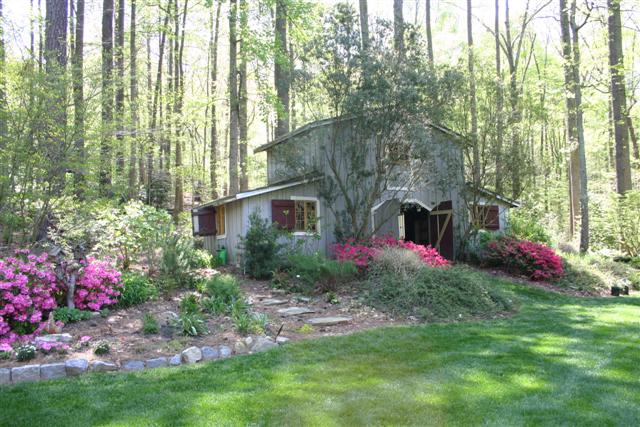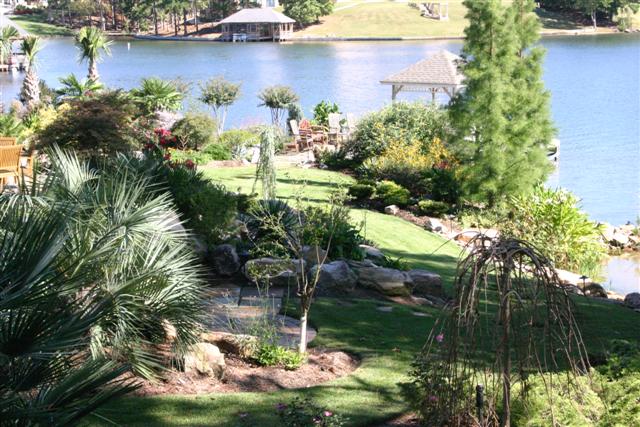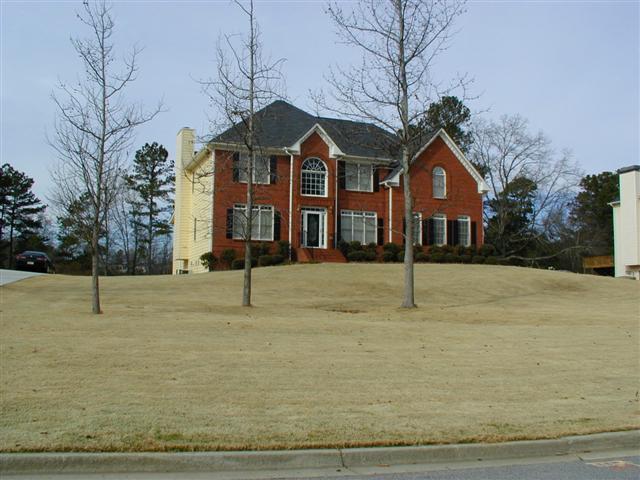Georgia Gardener Newsletter Design Tip: June 26, 2008
Grass from front to back and driveway to driveway
It currently costs $4.00 per gallon to fill your vehicle with regular unleaded and although we get smacked in the face with
these prices on a weekly basis, it's not the only place we're taking a hit. The effect of rising petroleum
prices has rippled through our entire economy including the care and maintenance of the traditional American lawn.
I'll confess up front that I'm not a fan of large expanses of lawn for a number of reasons.
My landscape (about one acre in size) has no lawn at all. A lawn-free landscape isn't going to work for many
people and I don't necessarily advocate getting rid of ALL the grass, but Americans (mostly men) have been obsessed for too long with
the pursuit of large expanses of the perfect, golf-course-like lawn. This may be a luxury that we need to let go of for both
economical and environmental reasons.
Environmentalists have been screaming for years that the lawn is an eco-unfriendly habitat that supports little biodiversity and
actually hurts the environment with chemical and air pollutants. Conversely, the various turf organizations tout the
positive aspects of turf saying it generates oxygen, reduces heat*, helps control runoff and erosion, etc. I suspect the truth
lies somewhere in between. I tend to give more weight to the environmentalists and their arguments.
Here are some lawn facts:
- Turfgrass is America's most irrigated crop, outpacing corn, wheat, barley and oats.1,2
- Turfgrass covers between 30-40 million acres in the U.S. (depending upon who you believe).3
- In 2005, Americans spent between $30-35 billion on lawn care products and equipment. 4
- Gas-powered lawnmowers in one hour emit the same amount of pollutants as a car driven 20 miles.4
- Most synthetic garden products (fertilizers, pesticides and herbicides) are petroleum-based.
- Over use of synthetic garden products contributes to nonpoint source pollution.5
- Most turfgrass species are not native to North America.
- Upwards of 60 percent of urban fresh water is used for irrigating lawns.4
- Using the figure that Americans burn 580 million gallons of gas per year in lawnmowers4, that now equals
$2.3 billion. This doesn't even cover leaf blowers and edgers.
These are some pretty sobering facts and with the rising cost of oil, the costs associated with owning a lawn are
only going to go higher. To be fair,
I believe that lawns have their place in many (but not all) American landscapes. Lawns provide a surface that is easy to
walk and sit upon, play sports and provide open areas for outdoor entertainment and living. Visually, they provide a
break between beds of other plants. However, I believe that lawns should be only a part of a healthy landscape and not
the major component.
How Much is Too Much?
Personally, I like to see the area comprised of turf to be about 1/4 to
1/3 of the overall landscape. If you have children that like to play on
the lawn or do a fair amount of outdoor entertaining, you could potentially
up that figure to half with a maximum of about 5,000-7,000 square feet
regardless of the size of your property. The remaining landscaped areas
would be comprised of trees, shrubs, flowers and edibles:


By removing turf and dedicating larger portions of your landscape to non-turf
plants, you reduce the amount of time and costs necessary to maintain a
lawn. Perhaps you could eliminate the lawn altogether, get rid of the lawnmower,
use less synthetic chemicals and irrigate less thus insulating yourself
from the effects of rising oil prices and the dwindling availability of
water.
Miscellaneous side note: The skyrocketing price of oil is also affecting the cost of food. Both Walter and I have noticed
an explosion of food gardening in response to these price increases. I've compared it to a modern-day "Victory Garden"
mentality. I recenly drove by a million dollar plus home in a fashionable Atlanta neighborhood that had removed a portion
of the front lawn and had it planted in tomatoes!
*And Finally...
As for the claims that turf areas can reduce the urban heat island effect, I conducted my own experiment. I used my
Kestrel® 3000 Weather Meter
to measure the temperatures 36 inches above the ground for asphalt, turf and tree-shaded areas:
- Asphalt measured 92.1 degrees
- An open lawn area measured 88.4 degrees
- A tree-covered landscape measured 79.9 degrees
So, turf areas are a bit cooler than asphalt, but tree-covered areas are
significantly cooler than turf. I'll take my wooded lot and my air conditioning
bills any day of the week, thank you very much.
"A society grows great when old men plant trees whose shade they know they shall never sit in." --- Greek Proverb
References
1. U.S. News and World Report
2. Nasa
3. Environmental Science & Technology
4. EPA
5. EPA
Additional Reading
1. Requiem for a Lawnmower, Revised Edition: Gardening in a Warmer, Drier, World. By Sally Wasowski
2. The Organic Lawn Care Manual. By Paul Tukey
3. Edible Estates: Attack on the Front Lawn. By Fritz Haeg
Copyright © 2008 by Theresa Schrum - All rights reserved
No part of this website may be reproduced without the expressed written permission of Theresa Schrum



